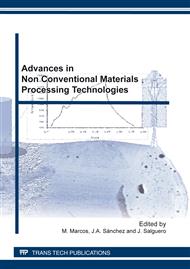p.97
p.103
p.109
p.115
p.121
p.127
p.133
p.139
p.145
Study of the Proper Sintering Conditions of Anionically-Polymerized Polyamide 6 Matrices for the Fabrication of Greencomposites
Abstract:
The present research work assesses the manufacture of long fiber thermoplastic matrix composite materials (GreenComposites). Thermoplastic matrices are too viscous to be injected into the conventional LCM (Liquid Composite Molding) molds, and then epoxy, polyester or vinylester resins are used. Nevertheless, the groundbreaking anionic polymerization of caprolactam allows such a synthesis of a thermoplastic APA6 matrix inside the mold. This matrix is sintered from the starting monomers, and presents high mechanical performance and recyclability. In order to do the reactive injection in a LCM mold, it is necessary to control the polymerization mechanism of such a thermoplastic matrix. This paper puts special emphasis on detecting and solving all problems which arose during synthesis. For instance, moisture values were assessed for all starting reactants, since humidity keeps polymerization from occurring. It is thought that once the synthesis and the resulting material characterization are well controlled, the manufacture of GreenComposites through in situ polymerization, as well as addition of state-of-the-art fabrics such as basalt, can proceed successfully.
Info:
Periodical:
Pages:
121-126
Citation:
Online since:
February 2012
Authors:
Keywords:
Price:
Сopyright:
© 2012 Trans Tech Publications Ltd. All Rights Reserved
Share:
Citation:


